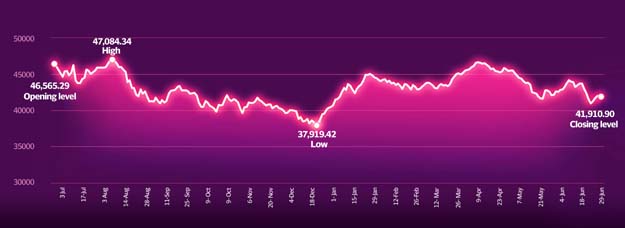Investors face 35pc loss in stock value over the year
THE Pakistan Stock Exchange (PSX) has been quietly celebrating its undeclared status as the best performing market in the region in 2018 year-to-date.
Up to May 4, the return for CY2018 dished out by the local bourse was 10 per cent. The returns disbursed by other markets paled in comparison as most markets grew below three per cent: India and Malaysia 2.5pc and Sri Lanka 2.2pc.
But, showcasing the performance for a little over four months of 2018 portrays a misleading picture. Over the last year since the KSE-100 Index hit an all-time high of 53,123 points on May 25, 2017, the Index has tanked 9,267 points to close trading last Thursday at 43,856 points.
Last Thursday, the Index managed to find a foothold and climb a bit to snap a seven day losing streak, but that still leaves the KSE-100 Index with a loss of 17pc over the course of a year (based on the average loss calculated on the 100 shares that comprise the benchmark KSE-100 Index).
Local individual and institutional investors who have front row seats in the public acrimony between political rivals have jettisoned shares and are running for cover in risk-free investments
Looking at the price erosion in numerous stocks over the year, it is easy to conclude that investors have been ruined. Calculations by this writer show that average loss on most stocks this past year still stand at an alarming 35pc — twice the loss of 17pc represented in KSE-100 stocks.
For the comparison of investors’ return, it is pertinent to draw an analogy between the share prices of a sample of individual stocks over a year — from May 25, 2017 (the index peak) to the current levels.
Most low-priced shares have been favourites of small savers and the volume leaders on most trading days. With almost a half of their savings gone, it is the small investor who has yet again taken the brunt of the blow. (See table)
But if the PSX was striding forward even in the first four months of the current calendar year, the winning streak was snapped by the announcement of the federal budget on April 27; surprising all.
In order to present a populist budget, Finance Minister Miftah Ismail bent over backwards announcing incentives and tax exemptions which the PSX had been clamouring for over the past four years. The package for the capital market was loaded with tax incentives and exemptions.
The budget 2018-19 decreed reduction in corporate tax by one per cent for the next five years to scale it down to 25pc by the end of financial year 2023; phasing out the currently levied super tax at three per cent for companies and four per cent for banks by one per cent every year, and restoration of the major exemption of tax at five per cent on bonus shares.
At the conclusion of the budget speech, market participants showered praise on Mr Ismail for offering what they termed was a “market friendly” budget. And yet the market extended a cool response.

In the seven trading sessions since the announcement of the budget, until last Wednesday, the market went on a losing streak with the KSE-100 Index poorer by 1,748 points, wiping out nearly four per cent of the year’s gains.
Disappointed market gurus started to find fault with the budget. Ignoring the massive incentives, the non-restoration of slab-wise regime of capital gains tax (CGT) and the status quo on tax on cash dividends was blamed for the market fall.
But investors’ worries have more to do with corresponding uncertainties: the balance of payments situation and the weakened growth outlook for Pakistan by the International Monetary Fund which revised the GDP growth rate down from 5.6pc to 4.7pc for FY19.
And above all, the bounties lavished in the budget were eclipsed by investors’ fear over the heated political atmosphere as the date for the appointment of a caretaker government followed by the general elections approaches.
Although most brokerage houses tend to mention the politically charged atmosphere in the country simply as “noise on the political front”, so as to keep their foreign clients pacified, the local individual and institutional investors who see the extent of the acrimony between political rivals, have jettisoned shares and are running for cover in risk-free investments.
Cheers

